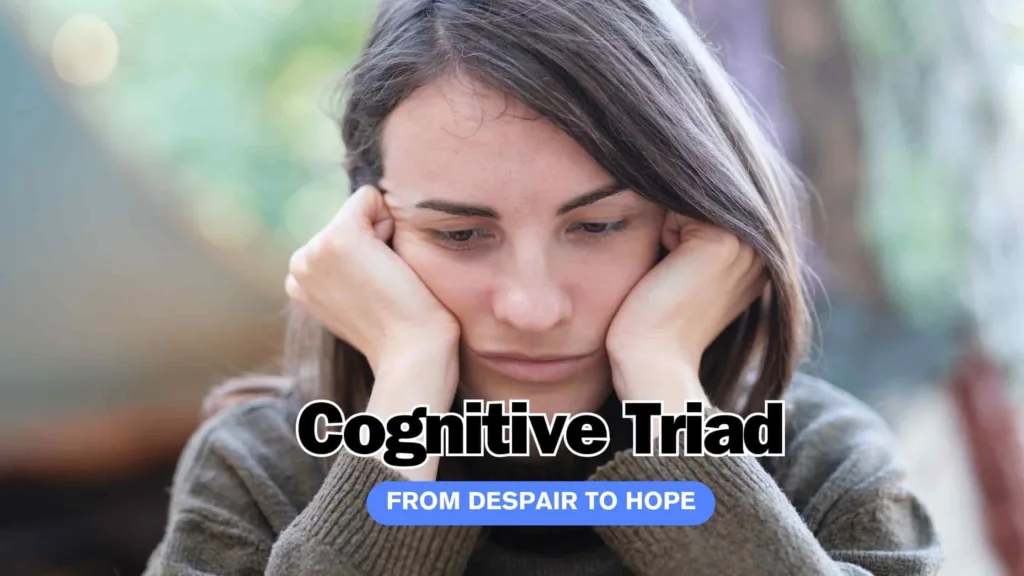Our minds are like complicated puzzles made up of thoughts, feelings, and actions that affect how we see the world and how we behave every day. A smart idea in psychology that helps us understand this puzzle is called the Cognitive Triad. This concept was created by a famous psychiatrist named Aaron T. Beck and is a crucial part of cognitive therapy. It helps us see how our thoughts, emotions, and behaviors are all connected and play a big role in how we feel mentally.
Definition of Cognitive Triad
The Cognitive Triad is like a guide that points out three things that can make someone feel not so good in their mind: bad thoughts, bad feelings, and bad actions. People use this guide, especially in something called Cognitive Behavioral Therapy (CBT), to learn how to change those not-so-helpful thoughts and start feeling better in their heads.
Let’s say someone often thinks, “I’m not good at anything.” That thought makes them feel sad, and then they avoid trying new things because they think they’ll fail. The Cognitive Triad helps people see these connections between thoughts, feelings, and actions

Key Elements of Cognitive Triad
Negative Thoughts:
Negative thoughts are like those unhelpful ideas that just pop into our heads without us wanting them. They’re like automatic habits that affect how we see ourselves, the world, and what might happen in the future. These thoughts can cause big problems for our feelings, making us really sad or worried, especially in conditions like feeling really down or anxious.
For example, let’s say someone often thinks, “I always mess things up, and I’m a total failure.” That’s an all-or-nothing kind of negative thought. It’s like seeing everything in extremes, and it makes them feel really down.
In therapy, which is like training for the mind, people learn to catch these negative thoughts and question if they’re really true. They might practice thinking differently, like saying, “I make mistakes, but everyone does. I can learn from them and do better next time.” This helps them feel better and see things in a more positive way, making their mind happier.
Related Article: Catharsis In Psychology: Unburden Your Soul
Negative Emotions:
Negative thoughts and feelings are like buddies – they go hand in hand. Imagine thoughts are like seeds, and feelings are the flowers that grow from them. When our thoughts are not so great, it makes flowers of emotions like sadness, anxiety, guilt, or shame bloom in our minds.
For instance, let’s say someone always thinks, “I’m not good enough for anything.” That thought is like a seed, and it grows into flowers of sadness or feeling not good about themselves all the time.
In therapy, which is like a school for our feelings, people learn to understand these sad or worried feelings. They find out that these feelings come from thoughts that might not be true. So, they practice changing those negative thoughts to something like, “I may not be perfect, but I’m still pretty awesome.” This helps them feel better, like having a garden full of happy flowers in their mind.
Negative Behaviors:
The third part of the Cognitive Triad is about what we do, like our actions and habits. When we’re not feeling good in our minds, sometimes it shows in the things we do.
For example, if someone often thinks, “I’ll always fail,” they might avoid trying new things, like not taking on challenges at school or work. It’s like they’re staying away from stuff because they think they’ll fail.
In therapy, which is like a guide to help us do better things, people learn to understand these actions. They realize that avoiding things comes from negative thoughts and feelings. So, they practice changing those thoughts and feelings. Instead of avoiding it, they might say, “I can give it a shot and learn from whatever happens.” This helps them stop avoiding and start doing things they avoided before, like opening the door to more happiness and success.
On Top of that
The Cognitive Triad is like a guide helping us understand how our thoughts, feelings, and actions are all connected. When we deal with the not-so-good thoughts and how they make us feel and act, it’s like giving our minds a positive lift. Cognitive Behavioral Therapy is like a toolbox that teaches us how to do this. It’s a friend that gives hope and practical tips for people who want to feel better in their minds.
Related Topic: Trepidation Definition: Whispers Of Fear

Pingback: Chronomentrophobia: The Fear of Clocks and Time
Pingback: Self Handicapping: Hiding behind the hurdles